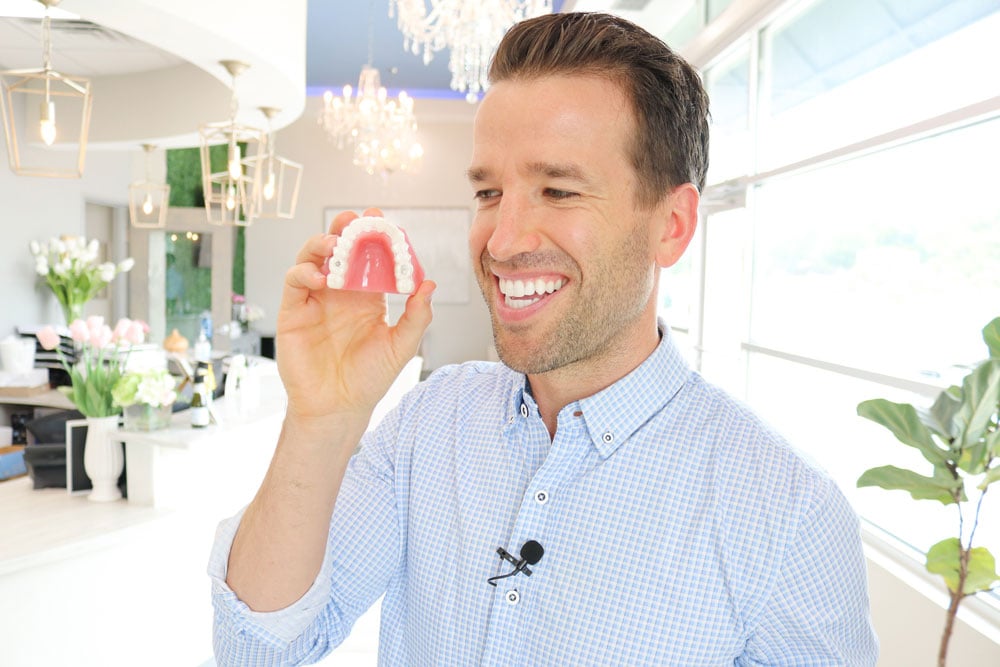Hi, I’m Dr. Nate from Thrive Dental and Orthodontics, and I want to talk to you about the ten things you should know before starting Invisalign treatment.
1. How much pain is associated with Invisalign?
The pain associated with getting Invisalign trays is very minimal. When we add the attachments to your teeth, there is no drilling or shots involved.
As far as the discomfort level experienced while moving your teeth, it will be similar to braces. The discomfort of Invisalign or braces is due to the fact that your teeth are moving. It does not matter if they are moving because of Invisalign or braces. Both processes are similar.
The discomfort of tooth movement typically lasts for a few days after putting in your first trays. You do not need strong medication other than your typical over-the-counter pain meds. The vast majority of patients do not take any pain medication during their entire treatment.
2. How often should you wear your aligners for the most predictable and reliable results?
To achieve optimal results, Invisalign trays must be worn in the mouth for 18-22 hours daily. They should be worn all the time except when you eat, drink, brush, and floss.
3. How do you keep your aligners clean?
Remember to brush your trays daily and wash them with a toothbrush or soak them in soapy water before putting them back in. Make sure to brush off excessive soap!
You can also try a product called Retainer Brite. If you want to know more about this, I will go over it in another video, which I will link here.
4. What are the attachments, and how do they work?
Attachments, like the name sounds, are little dimples that we put on your teeth so you can get a bit more leverage when moving them around. Attachments are glued on your teeth for the duration of treatment.
Invisalign attachments need to be removed with a high speed and bur to make your teeth smooth after treatment.
5. What’s the process of bonding and attachment?
Please check out my other video on how attachments are placed. You will see that we use etch, bond, and composite to bond the attachments. It is a very similar process to bonding braces, except the attachments are smaller.
It’s important to note that we do not drill your teeth or use anesthetic to bond your attachments. This is a quick and painless process.
6. What is ipr? And is it necessary with Invisalign?
Interproximal reduction can be defined as the process of polishing in between your teeth so that space is created. Sometimes this isn’t necessary, but when done, there’s always a specific reason, such as eliminating blank triangles or reducing the protrusion of your teeth!

7. Will your speech be affected?
When we place anything new in the patient’s mouth, their speaking capabilities can change. The change in speech is due to a thin piece of plastic between your teeth. Adapting to this position takes some getting used to, but with practice, most people find that they adapt rather quickly!
8. What type of beverages are best for aligners?
It’s important to know that tea and coffee will stain your teeth, so removing the trays is recommended before drinking anything colored or sugary. Lighter-colored drinks without added sugar or room-temperature water can be consumed while wearing the Invisalign trays.
9. What do I do if I mix and match my aligners?
Each aligner has your patient ID on it and the tray number, so if you look closely enough, you’ll be able to tell that it’s your tray and what tray number it is. Also, don’t worry, you can’t mix up the top and the bottom because they won’t fit!
If you aren’t eating or drinking, you should have your retainers in your mouth. The better you wear your aligners, the less you are likely to lose them.
Also, remember to keep your old aligners just in case you lose your current ones. If you lose your current Invisalign trays, we may need to order replacements, and you want to have your old ones, so your teeth don’t relapse. Make sure to call your orthodontist immediately if you lose any trays.
10. What happens at the end of invisalign treatment?
We will remove your attachments and give you retainers. These retainers are to be worn for three months and then for night-time wear from then on out.
It’s important to know that retainers are a lifelong commitment. Whether you choose braces or Invisalign, retainers must be worn periodically for the rest of your life.
Conclusion
The Invisalign process is easy and painless. You may experience discomfort and speech alteration when you start your Invisalign journey, but this is typically short-lived.
If you have questions about the Invisalign process, please do not hesitate to ask me!
Regards,



